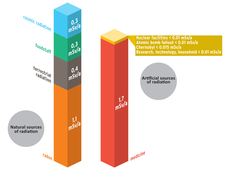Radiation exposure in everyday life
- Today people are not only subject to natural radiation but also to radiation caused by medical and technical applications.
- The dose rate measured by the ODL measuring network determines the external gamma radiation that a person is exposed to at the site of the probe.
- A dose rate of 0.1 microsievert per hour, which is a typical natural dose rate measured by the network, would lead to a total dose of around 1 millisievert per year.

![]() Everyone is exposed to radiation from natural and man-made radiation sources.
Everyone is exposed to radiation from natural and man-made radiation sources.
People have always lived in a radiating environment. Natural and man-made radiation sources lead to a certain radiation exposure. The quantity of such radiation exposure is called the "dose". Radiation exposure may have different impacts on human health, depending on its intensity.
What kind of radiation affects us?
Today people are not only subject to natural radiation but also to radiation caused by medical and technical applications.
An X-ray made at the dentist's, for example, leads to an increased radiation exposure. Holiday flights must be counted, too, since the flight altitude is associated with an increase in cosmic radiation.
Even radioactive substances that were blown into the atmosphere by above-ground nuclear weapons test or by the Chornobyl (Russian: Chernobyl) reactor accident in 1986 can still be detected today. (See Comparison of fallout from above-ground nuclear weapon tests, the reactor accident in Chornobyl, and the reactor accident in Fukushima)
What is a "dose rate" and how can I convert it into a dose?
The dose rate measured by the ODL measuring network determines the external gamma radiation that a person is exposed to at the site of the probe. This will usually be the sum of natural terrestrial radiation and cosmic radiation. In the event of an accident-related ambient contamination it would be possible to estimate the amount of the resulting additional external radiation exposure on the basis of this value.
A dose rate of 0.1 microsievert per hour, which is a typical natural dose rate measured by the network, would lead to a total dose of around 1 millisievert per year.
Comparing the numbers
A few typical dose values for better classification:
Annual natural radiation exposure = 2.1 millisievert
The annual natural radiation exposure (or, more exactly, the annual natural dose) to a person living in Germany amounts to 2.1 millisievert on average (effective dose). Depending on the place of residence, nutritional habits and lifestyle, this value varies between one and ten millisievert. The most important contributing factor is radon in dwellings which is accountable for 1.1 millisievert.
Transatlantic flight (back and forth) = 0.1 millisievert
A flight from Frankfurt to New York and back leads to an average effective dose of around 0.1 millisievert. Such a transatlantic journey thus causes an increase of five percent in the mean annual radiation exposure.
Medical examinations contribute significantly to man-made radiation exposure:
Thorax X-ray = 0.01 - 0.03 millisievert
A thorax X-ray accounts for 0.01 - 0.03 millisievert.
Whole-body computer tomography = 10 - 20 millisievert
If a whole-body computer tomography is performed, a grown-up person will receive a radiation dose of 10 to 20 millisievert.
When does it become dangerous?
Acute radiation damage will occur within a short time (days or weeks), if a person has been subject to a high radiation exposure (exceeding 500 millisievert). Such a high radiation exposure might occur after a nuclear or radiological accident in the immediate vicinity of the scene of the accident.
Even a lower radiation exposure can lead to health effects (in particular cancer) after many years or decades. The probability of such medical conditions rises with increasing levels of radiation exposure. Radiation protection experts assume that there is no lowest dose value below which a health risk can be definitely excluded.
More about the limit values can be found in the article "Limit values in radiation protection" on website www.bfs.de.

